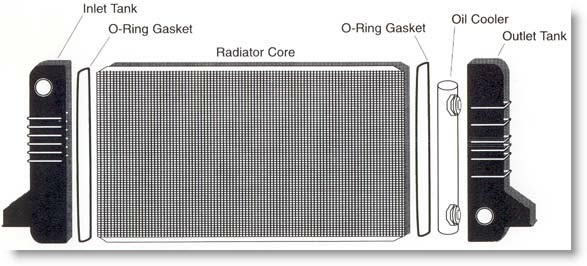|
|





If you notice any problems with this website, please email administrator@dannysradiator.com |
Copyright @2009 Danny's Radiator Service, LLC |
Engine Cooling System Diagram: |
Basic Radiator Assembly: |
Upper Radiator Hose and Thermostat # A large part of a radiator's function is made possible by the upper and lower radiator hoses. The upper radiator hose controls the flow of engine coolant from the radiator into the car engine. In a cold engine, engine coolant is stored inside the radiator. The engine coolant is held inside the radiator until the engine becomes hot enough to warrant engine coolant circulation. When an engine reaches operating temperature, the thermostat valve, which is located at the far end of the upper radiator hose, opens up and allows engine coolant to flow from the radiator into the engine. Lower Radiator Hose and Water Pump # As engine coolant circulates within a car's engine, it returns to the radiator via the lower radiator hose. The lower radiator hose provides the only connection for engine coolant to reach the radiator. The lower radiator hose, which is connected to the car's water pump, speeds up the flow of the circulating engine coolant and helps it to cool as it circulates through the radiator at high speeds. Engine Coolant # Engine coolant, otherwise known as radiator fluid, is a specially formulated liquid designed to retain as much heat as possible from a car's engine while maintaining its chemical integrity. Unlike plain water, which can either boil or freeze quite easily, engine coolant resists both extremes, which not only protects the radiator but also the car's engine |
How does a Radiator work? By: Jason Medina, eHow Editor |
Cools Engine Coolant # A radiator is repsonsible for dispersing, or radiating, the heat from circulating engine coolant or water. The temperature of a car's engine is controlled by circulating engine coolant that picks up heat generated from engine combustion and transports it directly to a car's radiator, where it is cooled and then returns to the car's engine. Without the radiator, a car's engine would quickly overheat and fail. The radiator, which is filled with small chambers and galleys through which engine coolant circulates, disperses the heat from the coolant into the outside atmosphere with the help of the radiator fan, which blows supercharged air directly through the radiator itself. The radiator fan, which is mounted directly in front of the radiator, is controlled either by engine power or by electronic control. Many car's have radiator fans that operate continuously; other car's have radiator fans that operate only when certain temperatures are reached. |